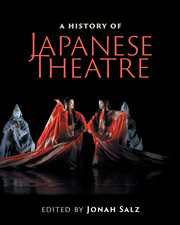Book contents
- Frontmatter
- Contents
- List of figures
- List of tables
- Contributors
- Contributors’ biographies
- Foreword
- Acknowledgments
- Note on Japanese terms
- List of abbreviations
- Timeline
- Editor's introduction
- I Traditional theatres
- Preface to Part I Japanese civilization arises
- II Modern theatres
- Preface to Part II
- 6 Birth of modern theatre: shimpa and shingeki
- Interlude Modern comedies and early musicals
- Interlude Takarazuka: all-girls’ revue and musicals
- 7 Rise of shingeki: Western-style theatre
- Interlude Manzai and Yoshimoto vaudeville comedy
- 8 Wartime colonial and traditional theatre
- Interlude Kami-shibai: picture-card storytelling
- 9 Maturing shingeki theatre
- Interlude Postwar musicals and commercial theatre
- 10 Sixties Theatre
- Interlude Butoh: dance of darkness and light
- 11 Contemporary theatre
- Interlude Tokyo: world theatre capital
- Interlude Charting Tokyo theatre today: 24 November 2012
- Interlude Modern theatre tomorrow: interview with Oriza Hirata
- III Arcs and patterns
- IV Theatre architecture
- Preface to Part IV Evolution of Japanese theatre architecture
- V Theatre criticism
- VI Intercultural influences
- Epilogue: Frozen words and mythology
- Further reading
- Index
- References
11 - Contemporary theatre
from Preface to Part II
Published online by Cambridge University Press: 05 July 2016
- Frontmatter
- Contents
- List of figures
- List of tables
- Contributors
- Contributors’ biographies
- Foreword
- Acknowledgments
- Note on Japanese terms
- List of abbreviations
- Timeline
- Editor's introduction
- I Traditional theatres
- Preface to Part I Japanese civilization arises
- II Modern theatres
- Preface to Part II
- 6 Birth of modern theatre: shimpa and shingeki
- Interlude Modern comedies and early musicals
- Interlude Takarazuka: all-girls’ revue and musicals
- 7 Rise of shingeki: Western-style theatre
- Interlude Manzai and Yoshimoto vaudeville comedy
- 8 Wartime colonial and traditional theatre
- Interlude Kami-shibai: picture-card storytelling
- 9 Maturing shingeki theatre
- Interlude Postwar musicals and commercial theatre
- 10 Sixties Theatre
- Interlude Butoh: dance of darkness and light
- 11 Contemporary theatre
- Interlude Tokyo: world theatre capital
- Interlude Charting Tokyo theatre today: 24 November 2012
- Interlude Modern theatre tomorrow: interview with Oriza Hirata
- III Arcs and patterns
- IV Theatre architecture
- Preface to Part IV Evolution of Japanese theatre architecture
- V Theatre criticism
- VI Intercultural influences
- Epilogue: Frozen words and mythology
- Further reading
- Index
- References
Summary
Japanese theatre in the 1980s inherited much of its style and dramaturgy from Sixties Theatre. To some extent this was not surprising, since so many key artists from that period – including Suzuki Tadashi, Ninagawa Yukio, Kara Jūrō, Ohta Shōgo, Inoue Hisashi, and Ohno Kazuo – continued to produce challenging and fresh work. Many younger playwrights, directors, actors, and other artists trained under masters of Sixties Theatre or were inspired by them. Themes explored by angura (underground, vanguard) playwrights – memory and loss, quixotic quests for identity, false or dubious gods and prophets – were taken up and developed in 1980s theatre. Structurally, 1980s drama inherited angura's complex and surrealistic dramaturgy – the collage technique mastered by Kara in which several motifs and narrative strands intersect, introducing wildly disparate elements culled from Western or Japanese popular and classical culture. Typically taking their shape and themes from fantasy and dreams, they call into question the nature of reality itself, a motif sounded with frequent recourse.
Post-1980s theatre moved from fringe to mainstream culture, such that the Sixties Theatre term “little theatre” (shōgekijō) hardly seems appropriate any more for describing angura's legacy. Today, Ninagawa's productions are typically staged for long runs in mid- to large-sized theatres like Theatre Cocoon or Nissay Theatre in Tokyo, for 700 to over 1,000 people. The most popular playwright to emerge from the late 1970s, Noda Hideki (1955–), drew an audience of over 26,000 people on one occasion (8 June 1986, in Yoyogi Stadium) and currently stages his plays at the 834-seat Tokyo Metropolitan Theatre, where he is artistic director. Theatre of this kind, amplified by microphones and projections, has more the character of a rock concert than the intimate club-like atmosphere of “classical” angura. Unlike the devoted and eccentric amateur actors of angura, Ninagawa and Noda depend for their popularity, and even artistic survival, on casting major celebrities, singers, and actors from television and cinema.
Yet this invasion of the angura spirit into mainstream theatre was not accompanied by a similar political mobilization. By the 1980s, the Japanese public had become increasingly conservative and complacent, accustomed to the miraculous nature of Japan's postwar reconstruction.
- Type
- Chapter
- Information
- A History of Japanese Theatre , pp. 326 - 348Publisher: Cambridge University PressPrint publication year: 2016



